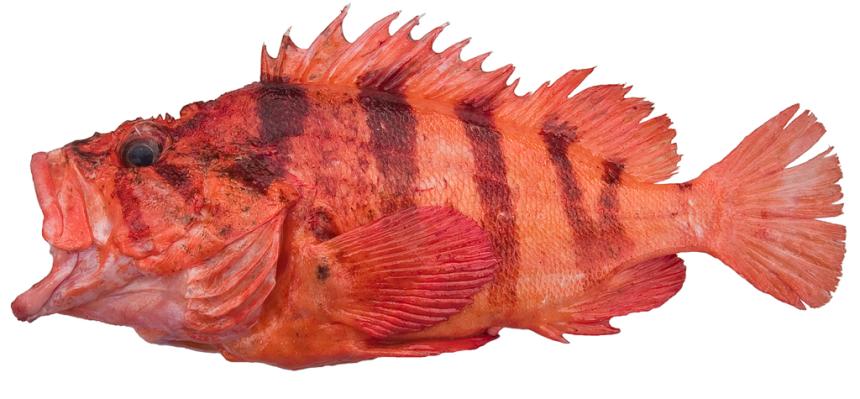Moderate-
High
Description and Range
Physical description
Tiger Rockfish are known for having distinctive markings. They typically have five vertical bars ranging in color from red to purple, brown, and black on their body over a pink to white base color. Additionally. there are two bars radiating back from the eyes. Some Tigers will appear to have had the last two bars fused together.
Tiger Rockfish can be confused with Flag and Redbanded Rockfish. The latter two species will only have four, thicker bars, to the Tiger’s five. Flag and Redbanded will also have their bars reaching onto the head.
Tiger Rockfish can grow up to 61 cm (24 in) in length and 3.4 kg (7.5 lb), living for up to at least 116 years.
Geographic range
Tiger Rockfish can be found from Kodiak Island, AK to southern California in depths from 18 m (60 ft) to 298 m (984 ft). This is a reclusive species which is typically associated with highly complex rocky habitat and will usually only venture out of these crevices in darkness.
Climate vulnerability
Sensitivity to climate change
High
The main sensitivity of tiger rockfish to climate change is likely to stem from changes to their prey base. Warmer ocean conditions could lead to decreases in prey (e.g., zooplankton) for both juveniles and adults, prompting decreases in adult fecundity and juvenile survival. Additionally, nearshore habitat loss due to sea level rise could impact juvenile survival, as juveniles tend to use nearshore habitat as nursery and foraging area. Deepwater coral habitat, which many adult rockfish use, may also decrease due to acidification, further reducing available habitat. Decreased oxygen levels may have direct physiological effects on tiger rockfish, leading to higher levels of mortality across various life stages. Due to their long life cycles and generation times, adults may be able to persist through short term pulses of negative ocean conditions (e.g., years with warmer sea surface temperature), though conversely, their low productivity could make it difficult for populations to recover from climate-related declines.
Exposure to climate change
Moderate-
High
- Increased ocean temperatures
- Sea level rise
- Declines in pH
- Decreased oxygen
Regulations
Rules and seasons
Recreational harvest within Puget Sound has been closed.
State record
- Weight
- 7.50 lbs
- Angler
- James Wenban
- Location
- Middle Bank, San Juan County
- Date Caught
- November 30, 1989
